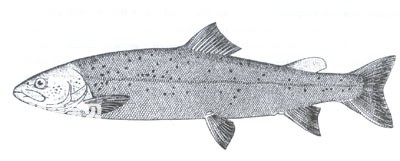Hucho bleekeri, also known as Hucho bleekeri and Hucho bleekeri, belongs to the order Salmoniformes, Salmonidae, and genus Hucho bleekeri. Commonly known as: Sichuan-Shaanxi Zheluo salmon, tiger fish, tiger fish, cat fish, largemouth fish, flower fish, cat fish. English name: Sichuan faimen, Hujia.
Endangerment level: Endangered. China's national level II protected wildlife.
The body is long oval, slightly flattened on the sides, and round in the abdomen. The mouth is large and diagonally slit, extending backward to the middle or below the posterior edge of the eyeball. The upper jaw is slightly protruding and slightly longer than the lower jaw; the maxilla is slender and extends backward past the back edge of the eye. The jaws, vomer and hyoid bones all have more thick teeth, which are tapered, with sharp ends and obliquely inward. The gill pores are large, and the gill membrane and gill isthmus are not connected. The eyes are larger. The scales are small, with 125-152 lateral line scales, and 3 axillary scales at the base of the pelvic fin. The lateral lines are straight. The back is dark gray and the belly is silvery white. There are small irregular gray-black spots in the shape of small crosses on the sides of the body and the gill cover. Pyloric caeca 65-120.

Hujia salmon is a cold-water fish that likes to live in deep-water bays or flowing water environments. The substrate is gravel or sand. It is located in foothill streams with an altitude of 700-1200 meters, and is sheltered by mountains on both sides. The river channel is narrow, the water flow is rapid, and the dissolved oxygen is low. Waters with lower volume and lower water temperature. Lively, strong swimmer, ferocious, and likes to be alone. It is a ferocious carnivorous fish whose food mainly consists of adults and larvae of fish and aquatic insects. The juvenile fish stage is dominated by aquatic insects, followed by small fish and benthic animals. Adult fish mainly feed on fish, but also eat aquatic insects, shrimps and water earthworms. The age of sexual maturity is mostly 3+ years old, and the reproductive period is from the awakening of insects to the spring equinox. The spawning grounds are mostly in shallow water areas near deep pools, where the water flow is slightly slow and the river bottom is gravelly and sandy. The broodstock fish have the habit of building nests to lay eggs. Before spawning, the broodstock fish first dig a round or oval shallow nest at a suitable river bottom, and then lay eggs.
The tiger-chia fish was abundant before 1960. It was a large economic fish in the production area. The maximum individual could reach 50 kilograms and the common weight was 0.5-2.5 kilograms. In addition, the meat was tender, delicious and rich in nutrients. People in the production area valued it. It is the finest edible fish.
Tiger and Jiayu are isolated in the upper reaches of some tributaries. Due to damming and water conservancy projects in the upper reaches of the river, sewage discharge from factories along the river, and soil erosion caused by extensive deforestation on both sides of the river, the living environment of Hujia salmon has been damaged to varying degrees, resulting in a large number of them. for reduction. In addition, because there are far more males than females in the natural population of Hujia salmon, and females carry fewer eggs; and local fishermen catch a large number of spawning broodstock during the spawning period, and even use poison, electrocution, and explosive fishing methods, which has become increasingly common. Reduced resources are more severely damaged.
The Hujia salmon is a species endemic to my country. It is currently known that the Hujia salmon is distributed in the upper reaches of the Minjiang River in northwest Sichuan, along the middle and upper reaches of the Dadu River to Qinghai Province, and in water systems such as the Sushui and Taibai Rivers in the upper reaches of the Han River at the southern foot of the Qinling Mountains. It is the southern species of this group and has important academic value in studying the formation of fish fauna and animal geography. Currently, the Hujia salmon has been listed as a national grade II wild protected animal. Its protection issues have attracted the attention of relevant departments, but due to lack of sufficient manpower, material and financial resources, it has not been effectively protected so far.
animal tags:
We created this article in conjunction with AI technology, then made sure it was fact-checked and edited by a Animals Top editor.